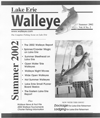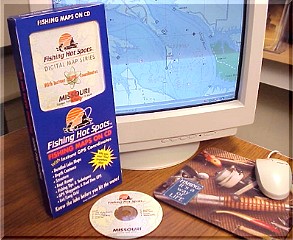As
Kevin Kayle wrestles with moving the Fairport Harbor Fisheries Research
Station into its new headquarters, he also must find the time to play tag
with the important task of monitoring the dynamics of Lake Erie’s fisheries.
"We’re still headlong into doing our data analysis and with our move,
it’s requiring a lot of juggling," said Kayle, supervisor for the Ohio
Division of Wildlife¹s fisheries research unit. This unit has moved from its
downtown Fairport Harbor location -- which was housed in an one-time
physician’s office -- to a much larger complex on High Street.
Kayle managed to stop long enough from tossing the rubber balls into the
air to discuss what lies ahead for Lake Erie’s fisheries. Of chief concern
and interest for most Lake Erie anglers is the status of walleye and the
opportunity to fill a cooler this summer. While the immediate forecast looks
good, the future is casting something of a shadow over the fisheries.
"The 2002 year class of walleye was almost a total bust. That was due to
the cold, wet spring that saw a lot of bad storms," Kayle said. Kayle did
say that plenty of spawning walleye adults were present last spring but that
conditions were not good for both egg and juvenile survival. "But the thing
that can help offset was that we had a good hatch the year before. And those
walleye should come into the fisheries this year as 12 to 15-inch fish,"
Kayle said.
In all, Lake Erie’s population estimates should project to be around 40
million. That figure is, however, a marked decline from the early 1980s and
into the 1990s when the lake had a walleye population approaching 80 million
fish, Kayle said. "These are numbers, however, which we’ve been seeing the
past couple of years," Kayle said.
Kayle ascribes to the theory that a hard winter is good for the walleye
fisheries. Good hatches often follow a hard winter, especially if a spring
is graced with good weather. Much of productivity is due to the physiology
of the fish, Kayle says.
Likely too, a hard winter means a thump on bait fish populations as well
as for egg-eating species such as white perch. While fewer white perch can
mean greater walleye egg survival, a smaller baitfish population can helps
fishermen. With less bait, a walleye is more inclined to "hit a spoon that
is dragged in front it," Kayle said.
As for yellow perch, a poor hatch also was encountered last year, Kayle
said. "This population is being offset by a good 2002 year class, but these
fish should be only 6 to 7 inches by fall," Kayle said. "We do have several
other good year classes of perch that are producing, and will continue to
produce, good catches. People just might have to sort through more fish."
Perch recovery efforts through conservative fishing regulations and the
imposition of strict quotas by all Lake Erie stake-holders is helping to
improve the species’ population, Kayle says.
"We could, though see regression if we have a couple more years of bad
hatches," Kayle said.
Among the brightest spots for Lake Erie is the recovery of its stock of
white bass. As it was for 1999 and 2001, the white bass hatch for 2002 was
good, Kayle said.
"The white bass fishing’s as good as it’s been in many years; it’s just
that they’re not being sought by as many fishermen. That could change as
more and larger white bass are caught," Kayle said.
Smallmouth bass populations are likewise strong. Good numbers of fish in
the 18- to 22-inch range are present, representing a population age 5 and
older, Kayle said.
"The one thing that we continue to monitor is the survival of young bass.
Our concern is the changing food web that involves the invasive round goby,
but they are being incorporated in the bass’ diet and so we’re
seeing faster growth rates with smallmouths," Kayle said.
Of course, the wildlife division’s steelhead stocking program will
continue to pour dividends into the lake’s fisheries, Kayle says. "We set a
record last summer for the number of steelhead taken from the lake: Just
over 40,000 trout," Kayle said. "Steelhead saved a lot of charters last year
and should do so again this year, absolutely."
Kayle said his staff is also looking at the lake’s population of fishhook
fleas. The concern is that the fishhook flea will be carried into new
waters. This transportation will come about by those fishermen who fail to
take precautions in cleaning fishing lines and downrigger cables, Kayle
said. "The fishhook flea was discovered for the first time last year in the
Central Basin," Kayle said. "We want to keep an eye on it."





